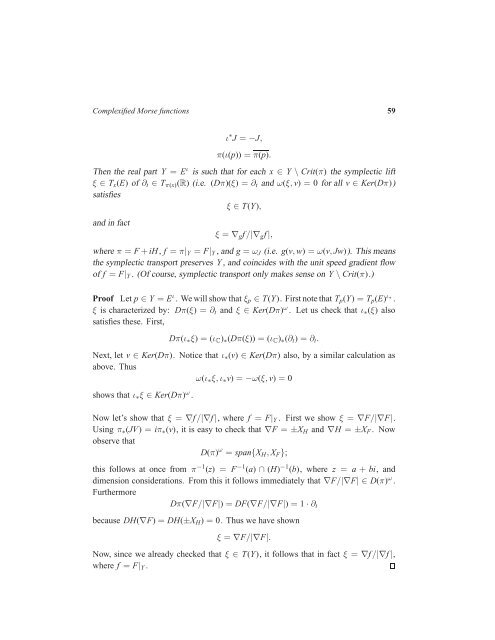The Picard-Lefschetz theory of complexified Morse functions 1 ...
The Picard-Lefschetz theory of complexified Morse functions 1 ...
The Picard-Lefschetz theory of complexified Morse functions 1 ...
Create successful ePaper yourself
Turn your PDF publications into a flip-book with our unique Google optimized e-Paper software.
Complexified <strong>Morse</strong> <strong>functions</strong> 59<br />
ι ∗ J = −J,<br />
π(ι(p)) = π(p).<br />
<strong>The</strong>n the real part Y = E ι is such that for each x ∈ Y \ Crit(π) the symplectic lift<br />
ξ ∈ Tx(E) <strong>of</strong> ∂t ∈ Tπ(x)(R) (i.e. (Dπ)(ξ) = ∂t and ω(ξ, v) = 0 for all v ∈ Ker(Dπ))<br />
satisfies<br />
ξ ∈ T(Y),<br />
and in fact<br />
ξ = ∇gf/|∇gf |,<br />
where π = F + iH , f = π|Y = F|Y , and g = ωJ (i.e. g(v, w) = ω(v, Jw)). This means<br />
the symplectic transport preserves Y , and coincides with the unit speed gradient flow<br />
<strong>of</strong> f = F|Y . (Of course, symplectic transport only makes sense on Y \ Crit(π).)<br />
Pro<strong>of</strong> Let p ∈ Y = E ι . We will show that ξp ∈ T(Y). First note that Tp(Y) = Tp(E) ι∗ .<br />
ξ is characterized by: Dπ(ξ) = ∂t and ξ ∈ Ker(Dπ) ω . Let us check that ι∗(ξ) also<br />
satisfies these. First,<br />
Dπ(ι∗ξ) = (ιC)∗(Dπ(ξ)) = (ιC)∗(∂t) = ∂t.<br />
Next, let v ∈ Ker(Dπ). Notice that ι∗(v) ∈ Ker(Dπ) also, by a similar calculation as<br />
above. Thus<br />
ω(ι∗ξ,ι∗v) = −ω(ξ, v) = 0<br />
shows that ι∗ξ ∈ Ker(Dπ) ω .<br />
Now let’s show that ξ = ∇f/|∇f |, where f = F|Y . First we show ξ = ∇F/|∇F|.<br />
Using π∗(JV) = iπ∗(v), it is easy to check that ∇F = ±XH and ∇H = ±XF . Now<br />
observe that<br />
D(π) ω = span{XH, XF};<br />
this follows at once from π −1 (z) = F −1 (a) ∩ (H) −1 (b), where z = a + bi, and<br />
dimension considerations. From this it follows immediately that ∇F/|∇F| ∈ D(π) ω .<br />
Furthermore<br />
Dπ(∇F/|∇F|) = DF(∇F/|∇F|) = 1 · ∂t<br />
because DH(∇F) = DH(±XH) = 0. Thus we have shown<br />
ξ = ∇F/|∇F|.<br />
Now, since we already checked that ξ ∈ T(Y), it follows that in fact ξ = ∇f/|∇f |,<br />
where f = F|Y .
















